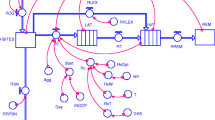Abstract
Five models of general epidemics, spatially homogeneous, were all shown to fit well to disease progress data forPhytophthora infestans on a susceptible potato cultivar. The models were: the logistic equation, the paralogistic or Vanderplank equation, two models from medical epidemiology with similar complexity, and a slightly more complex model with explicit treatment of lesion expansion. The use of the models for analysing the sensitivity of disease progress to changes in resistance components is discussed. Sensitivity analysis of the most complex model, by varying components within their range of genetic variation, indicates lesion expansion and infection efficiency as the components offering the best perspectives for resistance breeding. Improving two components simultaneously reduces disease progress slightly more than additively, but not enough to add other components to the list of breeding objectives. Pitfalls in using models for component sensitivity analysis, in the form of erroneous model initializations, are discussed, including implications for the role of components in the development of natural epidemics and in resistance breeding trials.
Similar content being viewed by others
References
Anderson, R.M. & May, R.M., 1982. Directly transmitted infectious diseases: control by vaccination. Science 215: 1053–1060.
Berger, R.D. & Jones, J.W., 1985. A general model for disease progress with functions for variable latency and lesion expansion on growing host plants. Phytopathology 75: 792–797.
Gees, R. & Hohl, H.R., 1988. Cytological comparison of specific (R3) and general resistance to late blight in potato leaf tissue. Phytopathology 78: 350–357.
Hethcote, H.W., 1976. Qualitative analyses of communicable disease models. Mathematical Biosciences 28: 335–356.
James, R.V. & Fry, W.E., 1983. Potential forPhytophthora infestans populations to adapt to potato cultivars with rate-reducing resistance. Phytopathology 73: 984–988.
Jeger, M.J., 1986. Asymptotic behaviour and threshold criteria in model plant disease epidemics. Plant Pathology 35: 355–361.
Jeger, M.J. & Groth, J., 1985. Resistance and pathogenicity: epidemiological and ecological mechanisms. In: Fraser, R.S.S. (Ed.), Mechanisms of resistance to plant diseases. Martinus Nijhoff, The Hague: 310–372.
Kermack, W.O. & McKendrick, A.G., 1927. A contribution to the mathematical theory of epidemics. Proceedings of the Royal Society of London, Series A 115: 700–721.
Lapwood, D.H., 1961. Potato haulm resistance toPhytophthora infestans. II Lesion production and sporulation. Annals of Applied Biology 49: 316–330.
Parlevliet, J.E. 1979. Components of resistance that reduce the rate of epidemic development. Annual Review of Phytopathology 17: 203–222.
Pietkiewicz, J.B., 1976. Characteristic of horizontal resistance to blight (Phytophthora infestans) (Mont.) de Bary in the potato. Ziemniak, 87–125.
Umaerus, V., Umaerus, M., Erjefält, L. & Nilsson, B.A., 1983. Control ofPhytophthora by host resistance: Problems and progress. In: Erwin, D.C., Bartnicki-Garcia, S. & Tsao, P.H. (Eds),Phytophthora: Its biology, taxonomy, ecology and pathology. The American Phytopathological Society, St. Paul: 315–326.
Vanderplank, J.E., 1963. Plant diseases: epidemics and control. Academic Press, New York, 349 pp.
Van Oijen, M., 1989. On the use of mathematical models from human epidemiology in breeding for resistance to polycyclic fungal leaf diseases of crops. In: Louwes, K.M., Toussaint, H.A.J.M. & Dellaert, L.M.W. (Eds), Parental line breeding and selection in potato breeding. Pudoc, Wageningen: 26–37.
Van Oijen, M., 1990. Modelling the influences of components of field resistance toPhytophthora infestans on disease progress in potato. Phytophthora Newsletter 16: 27–28.
Van Oijen, M., 1992. Evaluation of breeding strategies for resistance and tolerance to late blight in potato by means of simulation. Netherlands Journal of Plant Pathology 98: 3–11.
Zadoks, J.C., 1971. Systems analysis and the dynamics of epidemics. Phytopathology 61: 600–610.
Zadoks, J.C., 1977. Simulation models of epidemics and their possible use in the study of disease resistance. In: International Atomic Energy Agency (Ed.), Induced mutations against plant diseases: Proceedings of a symposium, Vienna: 109–118.
Zadoks, J.C. & Schein, R.D., 1979. Epidemiology and plant disease management. Oxford University Press, New York, 427 pp.
Author information
Authors and Affiliations
Rights and permissions
About this article
Cite this article
Van Oijen, M. Selection and use of a mathematical model to evaluate components of resistance to Phytophthora infestans in potato. Netherlands Journal of Plant Pathology 98, 192–202 (1992). https://doi.org/10.1007/BF01974382
Accepted:
Issue Date:
DOI: https://doi.org/10.1007/BF01974382




